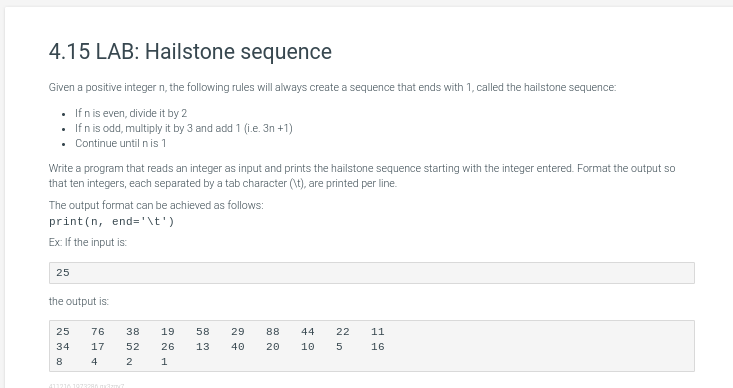4.15 LAB: Hailstone sequence Given a positive integer n, the following rules will always create a sequence that ends with 1, called the hailstone sequence: • If n is even, divide it by 2 • If n is odd, multiply it by 3 and add 1 (i.e.3n +1) Continue until n is 1 Write a program that reads an integer as input and prints the hailstone sequence starting with the integer entered. Format the output so that ten integers, each separated by a tab character (\t), are printed per line. The output format can be achieved as follows: print(n, end-'\t') Ex: If the input is: 25 the output is: 25 34 8 76 17 4 38 52 2 19 58 29 88 26 13 40 20 HNH 96 1 44 $ 10 22 11 5 16
4.15 LAB: Hailstone sequence Given a positive integer n, the following rules will always create a sequence that ends with 1, called the hailstone sequence: • If n is even, divide it by 2 • If n is odd, multiply it by 3 and add 1 (i.e.3n +1) Continue until n is 1 Write a program that reads an integer as input and prints the hailstone sequence starting with the integer entered. Format the output so that ten integers, each separated by a tab character (\t), are printed per line. The output format can be achieved as follows: print(n, end-'\t') Ex: If the input is: 25 the output is: 25 34 8 76 17 4 38 52 2 19 58 29 88 26 13 40 20 HNH 96 1 44 $ 10 22 11 5 16
Computer Networking: A Top-Down Approach (7th Edition)
7th Edition
ISBN:9780133594140
Author:James Kurose, Keith Ross
Publisher:James Kurose, Keith Ross
Chapter1: Computer Networks And The Internet
Section: Chapter Questions
Problem R1RQ: What is the difference between a host and an end system? List several different types of end...
Related questions
Question

Transcribed Image Text:4.15 LAB: Hailstone sequence
Given a positive integer n, the following rules will always create a sequence that ends with 1, called the hailstone sequence:
If n is even, divide it by 2
If n is odd, multiply it by 3 and add 1 (i.e.3n +1)
• Continue until n is 1
Write a program that reads an integer as input and prints the hailstone sequence starting with the integer entered. Format the output so
that ten integers, each separated by a tab character (\t), are printed per line.
The output format can be achieved as follows:
print(n, end='\t')
Ex: If the input is:
25
the output is:
25
34
8
76
17
4
38
52
2
19
58
29
26 13 40
1
88
20
44
10
16
22 11
5
16
Expert Solution
This question has been solved!
Explore an expertly crafted, step-by-step solution for a thorough understanding of key concepts.
This is a popular solution!
Trending now
This is a popular solution!
Step by step
Solved in 2 steps with 2 images

Recommended textbooks for you

Computer Networking: A Top-Down Approach (7th Edi…
Computer Engineering
ISBN:
9780133594140
Author:
James Kurose, Keith Ross
Publisher:
PEARSON

Computer Organization and Design MIPS Edition, Fi…
Computer Engineering
ISBN:
9780124077263
Author:
David A. Patterson, John L. Hennessy
Publisher:
Elsevier Science

Network+ Guide to Networks (MindTap Course List)
Computer Engineering
ISBN:
9781337569330
Author:
Jill West, Tamara Dean, Jean Andrews
Publisher:
Cengage Learning

Computer Networking: A Top-Down Approach (7th Edi…
Computer Engineering
ISBN:
9780133594140
Author:
James Kurose, Keith Ross
Publisher:
PEARSON

Computer Organization and Design MIPS Edition, Fi…
Computer Engineering
ISBN:
9780124077263
Author:
David A. Patterson, John L. Hennessy
Publisher:
Elsevier Science

Network+ Guide to Networks (MindTap Course List)
Computer Engineering
ISBN:
9781337569330
Author:
Jill West, Tamara Dean, Jean Andrews
Publisher:
Cengage Learning

Concepts of Database Management
Computer Engineering
ISBN:
9781337093422
Author:
Joy L. Starks, Philip J. Pratt, Mary Z. Last
Publisher:
Cengage Learning

Prelude to Programming
Computer Engineering
ISBN:
9780133750423
Author:
VENIT, Stewart
Publisher:
Pearson Education

Sc Business Data Communications and Networking, T…
Computer Engineering
ISBN:
9781119368830
Author:
FITZGERALD
Publisher:
WILEY